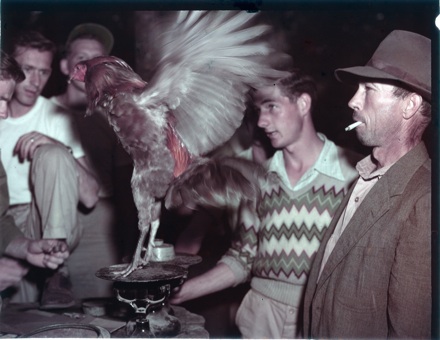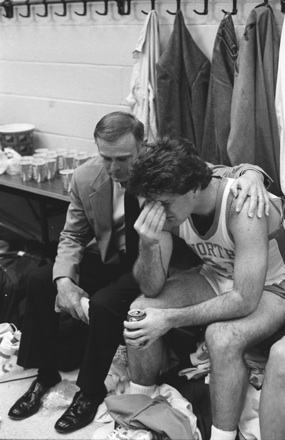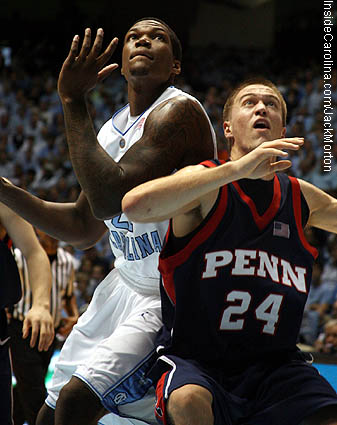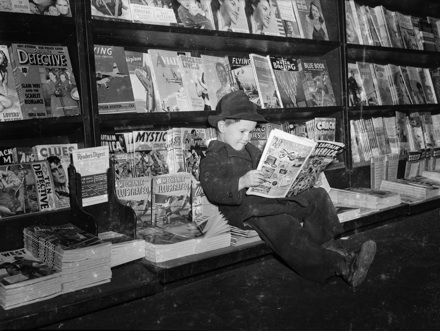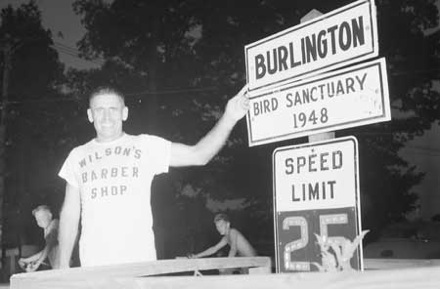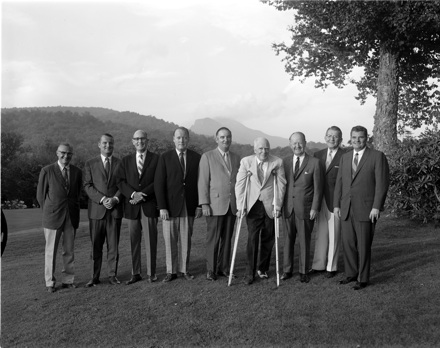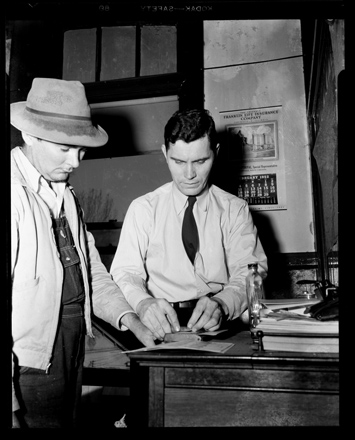Yesterday’s truly remarkable North Carolina-related plane crash reminded me of some negatives from the Morton collection depicting the January 6, 1960 crash of National Airlines Flight 2511 near Bolivia, NC (outside Wilmington).
Both US Airways 1549 and NAL 2511 were headed out of New York City (1549 bound for Charlotte, 2511 for Miami), but their outcomes were decidedly different. While (thankfully) all 155 US Airways passengers and crew survived, on 1/6/1960, all 34 on board were lost. And the culprit was not a bird but a bomb.
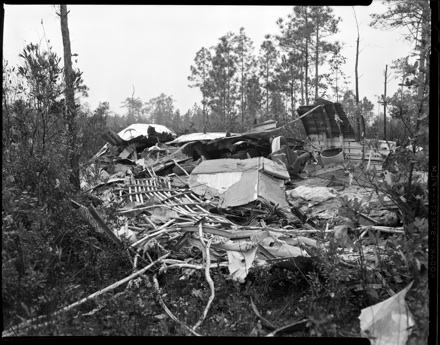
The story of NAL Flight 2511 is gripping and remains unresolved. The cause of the crash was a dynamite bomb, originally believed to have been detonated by a passenger named Julian Frank in a murder-suicide. (Frank was being investigated for fraud and embezzlement and had bought valuable life insurance policies prior to the crash).

Other evidence, however, brought Frank’s guilt into question. Remarkable similarities to the crash of NAL Flight 967 a few months prior led some to suspect that the two incidents were connected. No one was charged in either case.

The full Civil Aeronautics Board Accident Report for NAL Flight 2511 is available online (click on “Historical Aircraft Accident Reports” to find it)—but be warned, some details (like some of Morton’s photographs not included in this post) are not for the squeamish.
Category: Photojournalism
Birds with "grit and saucy swagger"
“It is not a bad sport, legal or illegal. At a time like this when the ‘inferiority complex’ is stalking around loose seeking whom it may devour, to see a bird, stuck and stabbed until almost bloodless, rise in his might and make one more supreme effort that finishes his enemy is a useful life’s lesson.”
This stunning quote comes from Bishop Joseph B. Cheshire’s 1930 memoir titled Nonnulla: Memories, Stories, Traditions, More or Less Authentic (links to a fully-digitized version). Since I paid brief homage to turkeys in the last post, I thought I would shift over to chickens for this one, specifically gamecocks. A small cache of cockfighting images in the Morton collection piqued my interest, so I did a bit of research into the history of this illicit “sport” in North Carolina.
A pair of articles from The State magazine from 1953 (the July 11 and September 5 issues) shed some light, leading me to the Cheshire book quoted above and to another 1949 memoir by Paul B. Barringer entitled Natural Bent, both of which include fascinating accounts of and opinions about cockfighting. (Although Morton’s cockfighting photos were taken around 1953 or perhaps a few years earlier, they were not used in either of the State articles).
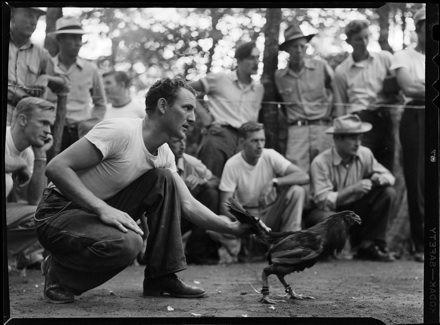
The sport is as old as the state itself. From “Cockfighting: an Early Entertainment in North Carolina,” a 1965 North Carolina Historical Review article by B. W. C. Roberts, I learned that the first published mention of NC cockfighting dates from 1737, and that Sir Walter Raleigh himself “enjoyed a favorable reputation as a cocker.” I also discovered that “the owners of cocks considered them treasures and bred [them]…as if they were thoroughbred horses.”
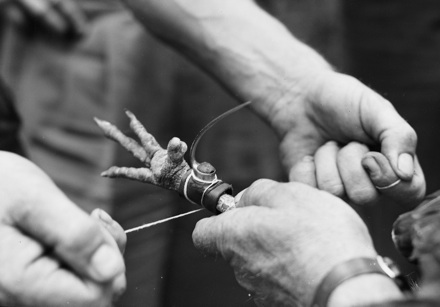
Roberts provides us with the unpleasant detail that “steel-pointed, razor-sharp gaffs, varying in length from an inch-and-a-quarter to over three inches, were fastened to the cocks’ shanks.” And as we can see from the cropped Morton image below, the fights, or “mains,” were not just entertainment for men, but for women and children as well.
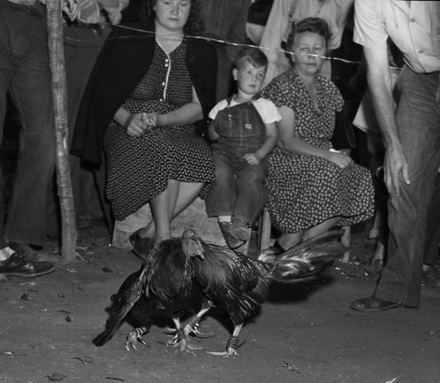
Judging from these various accounts and images, it seems that cockfighting practice changed little from the 18th century through the mid-20th. Although outlawed for quite some time, the practice has obviously continued for centuries, and remains a problem (as evidenced by Governor Easley’s 2005 signing of a bill to make cockfighting punishable as a felony).
Does anyone know the story behind these extraordinarily vivid Morton images? Where and when were they taken, and for what purpose?
Courtside Morton(s)
Tonight the University of North Carolina Tar Heel men play a game of basketball against UC-Santa Barbara.
My image scanning and processing this month has consisted of mostly basketball photographs, and according to a rough estimation they outnumber the usual celluloid suspects — bears, battleships, and pageant queens — by a significant margin. Therefore I have many pictures to choose from, and I feel slightly overwhelmed by all the options, all of which are excellent.
Thanks to a long tradition of basketball movies, I have been given the impression that basketball is about more than slam dunks and court-side gesticulations. Hugh Morton’s photos do not dispel this perception: in the collection there are a host of photographs from locker rooms, press conferences, dinner parties, and airplanes.
Here is an optimistic photograph, to begin with: a very backstage shot of a very sleepy men’s basketball team returning home on an airplane after their 1982 NCAA championship victory in New Orleans. (Note the young Michael Jordan two rows back on the left, and that looks like James Worthy in the front right, cuddling with his pillow).
Here is another off-court shot, of a very despondent, soda-drinking player in the locker room. The man, presumably a coach, assistant coach, or general father figure, is trying to encourage him in vain.
Moving on in the basketball summary, here is a highlight from the collection of on-court photographs. After seeing this, I wonder if maybe basketball really is just about slam dunks.
Carolina, in a game against Duke, is trailing slightly (36-42 according to the scoreboard), but I wonder, did this momentous dunk-in-progress by Michael Jordan change things? Was this one of the seminal Carolina-Duke match-ups, or merely another entry in the tally of this legendary rivalry?
My idea on this photo is that, because it was taken in the Greensboro Coliseum, it might be from the ACC tournament on March 10, 1984. If so, then Duke ended up winning, 75 to 77. But I can never be sure, as the photos I process often come to me in the form of loose, undated and unlabeled film negatives, and I have no context for the picture aside from embedded details (nametags and calendars are always welcome!). Can anyone help me identify the particular game?
To close, I have a photo from Hugh’s grandson Jack Morton, who has apparently inherited his Tar Heel photographer’s pass, and is documenting the exploits of current UNC basketballers. More of Jack’s photos from the Nov. 15 Carolina-Penn season opener can be viewed here. It is pretty neat to see the family continuity, isn’t it?
LIFE photo archive online!
As the Guardian reports, one of the largest and richest 20th-century photo collections is now (at least partially) online, thanks to a partnership with Google. The Life magazine photo archive can be searched/browsed from a dedicated Web page, or by doing a regular Google image search with “source:life” at the end.
As mentioned previously, we know that Hugh Morton submitted and published photos in Life — does anyone know of specific issues? His work is not represented in the Google archive as of now, but with plans for 10 million photos to be made available, maybe he will pop up yet?
McCauley digital collection launched
The NCC Photo Archives is very pleased to announce the availability of the Edward J. McCauley digital collection, consisting of photos McCauley, a photojournalist and life long resident of Burlington, N.C., took between 1952 and 1972 (mostly for the Burlington Daily Times-News). Most of the images in the digital collection depict political campaigns/elections and other events in and around Alamance County (note that this represents only a small percentage of the nearly 90,000 images found in the Edward J. McCauley Photographic Materials).
I’m sharing this news on A View to Hugh for two reasons. One, because McCauley and Morton were contemporaries (as discussed by my colleague Patrick in a previous post), and often took photos at/of the same events — thus, McCauley’s photos are bound to be of interest to our readers. The second reason is to show an example of the types of “products” we will be creating soon for the Hugh Morton collection (i.e., a finding aid and a searchable digital collection in CONTENTdm, the platform used by UNC Libraries for digital publishing).
Browse away, and enjoy!
Making a Difference in NC
Thus far, our student assistant David’s scanning efforts have been focused on what I call the “loose strips”—the unlabeled, unidentified masses of negatives that need to be inspected before we can decide what to do with them. (The inspecting, of course, becomes much easier when you can look at a positive on a computer screen versus a negative on a light box).
We decided recently, however, that since David is so darn good at scanning, we should probably have him work on some of the “good stuff” as well. (This term refers to Morton’s images of well-known people and events—it’s certainly not to say that the loose strips aren’t loaded with “good stuff”). So, I got David started on the images that were either considered for or used in Hugh Morton and Ed Rankin’s 1988 book, Making a Difference in North Carolina. As the book’s introduction reads:
The people, groups and events [depicted in the book] were chosen on the basis of the impact they have had, or are having, on life in North Carolina. Most of the photos have never been published before. And all have captions and text brimming with first-hand knowledge and experiences of the authors.
What could be better? Certainly a far cry from the jumble of “loose strips.” And the images themselves are beautiful. Take for example this portrait of Governor J. Melville Broughton, a cropped version of which appears on page 47 of the book (click the image to see the description):
I also love this image of the “Iron Major” Governor, R. Gregg Cherry, with a group of (Miss North Carolina?) pageant contestants. This one wasn’t used in the book, so I don’t know the details. But I do wish they still made swimsuits like these!
And then there’s that perennial Morton favorite, Luther Hodges (on crutches, below—this image wasn’t used in the book, either). That’s Grandfather Mountain in the background, and they appear to be on a golf course, so perhaps this image is somehow related to the Grandfather Golf and Country Club? Anyone know what’s wrong with Luther’s foot, or who these other men are? (Based on the IDs you lovely readers provided for this photo, I think that’s John Williams to the left of Hodges).
Camera Clinic this weekend
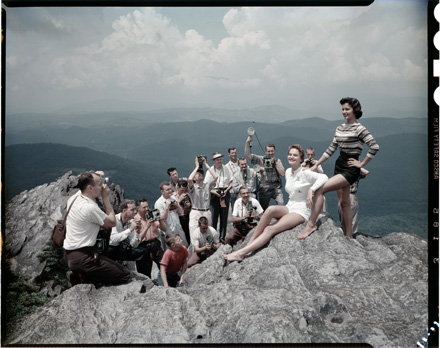
This coming weekend (August 16-17) is the annual Grandfather Mountain Camera Clinic, founded by Morton in 1952 as a networking and educational opportunity for photojournalists—and one of the events that helped earn him the titles of “photographer’s photographer” and “the father of N.C. photojournalism education.”
From the Grandfather website: “A freelance newspaper photographer himself, Morton wanted to know more about his craft and thought other photojournalists from around the region would enjoy the opportunity to learn as well. He began by inviting nationally prominent photojournalists to come to Grandfather Mountain to share information and inspiration with their Carolina counterparts. For many years the Carolinas Press Photographers Association held its annual meeting at this event, and although the NCCPA no longer sponsors the Clinic, many of its members continue to attend faithfully.”
On a related note, two photographers have been named 2007 “Hugh Morton Photographers of the Year” by the North Carolina Press Association: (Ethan Hyman of the News & Observer and Derek Anderson of the Independent Weekly). Visit the award’s Web page to see samples of their work!
This sounds familiar. . .
It’s been an exciting few weeks in North Carolina politics! Not only did last Tuesday’s primary inspire huge numbers of new voter registrations and shatter voter turnout records, for the first time in seemingly forever, it appears the state may have played a very important role in determining the Democratic nominee for President. I suspect these events would have thrilled Morton—a lifelong, committed Democrat and onetime gubernatorial candidate.
So it seems like a good time to share these two Morton slides, scenes from the 1960 Democratic National Convention in Los Angeles, showing supporters of John F. Kennedy and Lyndon Baines Johnson, respectively. Despite heated clashes between the two during the primaries, Kennedy and Johnson ended up forming a joint ticket (with Kennedy on top), which went on to (narrowly) defeat Richard Nixon in the general election.
Here’s an interesting quote from the Wikipedia page about the 1960 election:
Kennedy was initially dogged by suggestions from some Democratic Party elders (such as former President Harry Truman) that he was too youthful and inexperienced to be president; these critics suggested that he agree to be the running mate for a “more experienced” Democrat. Realizing that this was a strategy touted by his opponents to keep the public from taking him seriously, Kennedy stated frankly ‘I’m not running for vice president, I’m running for president.’
The dreaded "miscellaneous"
As I near the end of my initial sort through the Morton negatives, I am forced to confront that evil category: “miscellaneous.” Most archivists hate that word, and try to avoid using it in their descriptions, because it is so very useless in terms of letting people know what a collection or grouping actually contains. But the fact is, some images just don’t fit into any of the subject categories I’ve established. Photos of car accidents . . . unidentified living rooms . . . a piece of needlework . . . half a sandwich and a cup of soup. How to classify these? I’ll have to figure that out at some point, but for now they’re resting under the nasty M-word.
Also under the M-word (for now) are images I’m unable to identify well enough to know whether they might fit into one of my existing categories. The intriguing image below is one such case. It dates probably from the early 1950s, is in an envelope labelled “Atom Artillery Bn.,” and shows men in uniform boarding a large ship. I’m guessing it has something to do with atomic artillery (first tested in 1953), but what does “Bn.” stand for? (Battalion, perhaps)? Where was it taken? Does anyone know the 1,000 words behind this one?
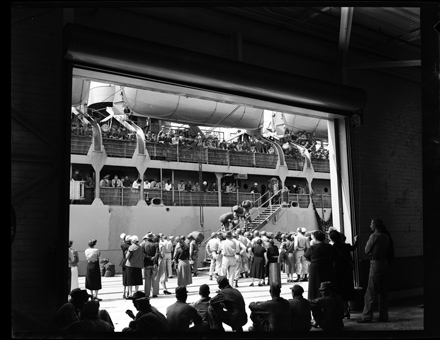
The Klan in NC
It’s another of those “1,000 word” moments, where a Morton image sends me off on a journey of discovery. On my recent visit to Grandfather, Hugh’s wife Julia told me the following story: she and Hugh got a speeding ticket in 1945 while driving through Columbus County, NC, on the way back home after their honeymoon. A few years later, Hugh was assigned to photograph the arrest of a supposed K.K.K. leader in Columbus County—Morton went to the jail, and to his surprise the man being arrested turned out to be the same man who had given them the speeding ticket. Mrs. Morton couldn’t quite recall his name, but thought it was “Early Bird” or something odd like that.
So, when I saw the negative envelope labeled “K.K.K.,” I thought to myself, maybe these are the negatives Mrs. Morton mentioned . . . and indeed, they do show a man being fingerprinted. I noted that the calendar on the wall read Whiteville, NC (in Columbus County), February 1952.
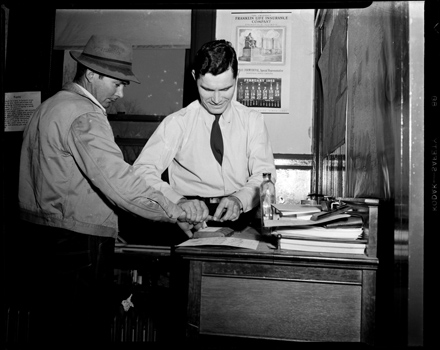
To my surprise, a quick web search for the K.K.K. in this time and place returned a bounty of fascinating information. First I learned that the 1953 Pulitzer Prize for Public Service in Journalism had gone to the Whiteville News Reporter and Tabor City Tribune, two weekly newspapers, “For their successful campaign against the Ku Klux Klan, waged on their own doorstep at the risk of economic loss and personal danger, culminating in the conviction of over one hundred Klansmen and an end to terrorism in their communities.”
Then I read about something called the Carter-Klan Documentary Project, being run right in our backyard at the UNC Center for the Study of the American South. This is an effort begun in 2003 to create a documentary film and other multimedia elements about the work of W. Horace Carter (then editor of the Tabor City Tribune) and others to combat the early 1950s Klan insurgency in Columbus County, led by Grand Dragon Thomas Hamilton. The timeline on the project’s detailed website describes the events of February 16, 1952, when “more than 35 FBI agents, working in close coordination with state and local law enforcement officials in Columbus County, N.C., arrest 10 Klansmen for the kidnapping and flogging of Ben Grainger and Dorothy Martin on October 6, 1951,” and says that several other area Klansmen were arrested from February to May of 1952.
Far down on the Thomas Hamilton page, I found a photo (below, from the Raleigh News & Observer) and description of Early Brooks, a former Fair Bluff policeman who led “the most vicious and active klavern” in Columbus County. “Eureka!,” I exclaimed to myself, a former policeman named “Early”—this has to be the guy. But when I compare the photos, I actually don’t think it is the same person. What do you think? If it’s not Early Brooks, who is it? And who is the arresting officer?
One last note about all this: in searching the UNC libraries catalog for information about W. Horace Carter, I found an oral history interview conducted with Carter in 1976 as part of the Southern Oral History Program (available online, both audio and transcript). Turns out Carter and Hugh Morton went to UNC-Chapel Hill at the same time—Carter was editor of the Daily Tar Heel in 1944, and Morton took photos for campus publications . . . surely they knew each other. Did Carter give Morton the assignment in 1952? Was the photo published? I hope someone can fill in the details.

